

![[IMAGE]](../bilder/mechs1.jpg) |
Authors: Publisher: No. of Players: Awards: |
![[IMAGE]](../technik/box/rot/rot-7.gif) ![[IMAGE]](../technik/box/gelb/gelb-10.gif) ![[IMAGE]](../technik/box/grun/grun-8.gif) ![[IMAGE]](../technik/box/pink/pink-7.gif) ![[IMAGE]](../technik/box/blau/blau-9.gif) |
|
Gamebox author Ralf Togler writes about the game:
League of Legends by RIOT GAMES is a multiplayer online video game, in which players meet in an fighting arena with their champions to battle against a team of other players. All champions have unique abilities that can be unlocked while rising in levels. Far over 100 million people are playing the game, each month! So it is one of the most successful video games in recent years.
Now, as you know, Kulkmann's G@mebox only reviews boardgames. So, why I am telling you all this stuff about video games? It is quite simple: in the last year RIOT GAMES has published a tabletop version of the game. Mechs vs. Minions is its name. And only recently they released a multi-language version of the game. Well, it is not exactly the same game as League of Legends. But as in the video game, players are set in a battle arena to lead their champions, called Mechs in the boardgame, against a horde of enemies, the Minions. So it is kind of a merchandise product, you might ask? Yes and No. Of course, if a video game publisher releases its first boardgame in the world of its most successful video game, it is only logical to associate this baordgame with a merchandise product. But would they be in need of it? Aren't 100 million players each month enough?
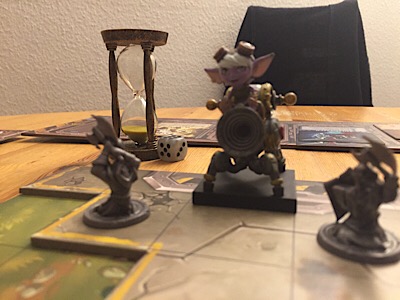 When I first saw the gamebox and what's inside, I was sure that there must be more behind the facade. A sheer mass of game material, awesome miniatures, a campaign modus with scenario-based introductions of the rules, and a game mechanism similar to one of my all-time favourites, Robo Rally. Nobody would publish such a sophisticated game only for reasons of merchandise. At least, that's what I was hoping. To come straight to the point, my initial assessment was right. Mechs vs. Minions is definitely one of the hottest games of the last and the current year. So let us have a closer look at the game mechanics: Unlike the video game, Mechs vs. Minions is a fully cooperative game. 2-4 players take the role of Heimerdinger, Tristana, Corki, and Ziggs, who are Yordle mechanics that have built their own Mechs. A Mech is the abbreviation for a mechanical battle suit. And this suit has to be programmed to move, rotate and shoot on the gameboard. As said, the game is scenario-based. Ten different missions introduce the rules consecutively. At the beginning these missions are still secret, as they come in sealed envelopes. And the same applies to a lot of the game material. Only the miniatures, most of them without function in the first missions, are visible to the players. But additional game material, for example new type of cards, isn't accessible at the beginning as it is still embedded in the sealed envelopes. 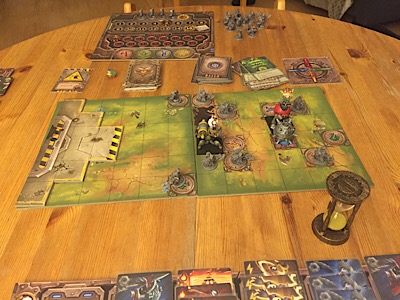 So, it is very easy to start playing the game: In the school of Rumble, the headmaster of our mechanic school, we are introduced to program our Mechs, and after a short reading we immediately can begin to play. This concept is followed up in the missions. Each sealed envelop contains more rules, and often the rules in these missions are introduced gradually again. This is called Escalation, or in other words: as soon as certain conditions or circumstances are met, a new rule comes into play. For example, minions could spawn or a bomb could explode in response to certain player actions. In the end, we never have to read more than about 5 minutes, before we can start or restart to play. A prerequisite, however, is that all player already know the rules from previous missions. So it is recommended that you play the campaign with the same group of people, or at least that most players are the same. I think the latter is enough, because the basic rules are too complex as you will see. 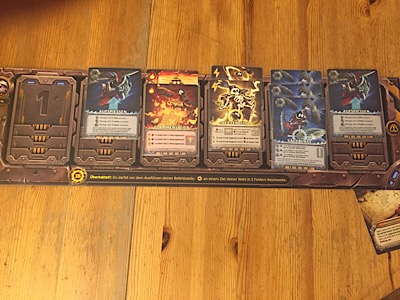 After set up, in wich we build up the map, place our Mechs and our opponents, the minions, the player start with an empty command line that has six free slots for their command cards. New cards are drawn and distributed at the beginning of each round. We normally start the round with 5 new cards from which 4 are taken by the players, one by one. Depending on the number of players, each Yordle gets one or more new cards that he or she can program into one of the six slots. As a result, you always start the mission with a stupid Mech. Mechs vs. Minions distinguishs three different types of Command Cards: Move Commands, Turn Commands and Attack Commands. The first two types are similar to the programming cards in Robo Rally, although some are a little bit more complex or triggered. The Attack Cards are sometimes triggered too, and can best be compared with the cards in Tash Kalar. They usually deal one damage to one or more opponents on the board in certain directions. However, there is a one big difference to Robo Rally: once a Command Card is played into a slot, it remains there until it is scrapped or another card is played on top of it. In other words: If you play a Command Card that allows you a 90° rotation into your second slot, your Mech will do a rotation as a second step in this round and all other rounds to follow. We already know something similar from Robo Rally when your robot is damaged, with the result that some of the slots become jammed. So it is very important to look ahead for your next turns too, or you will end up endlessly ramming a wall... 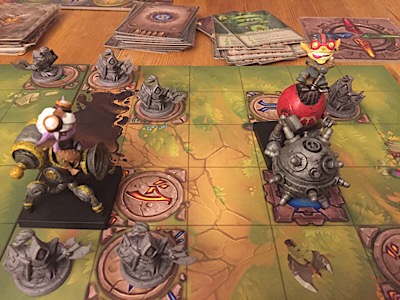 After all Mechs have performed their movements, the minions on the board move too. This movement again is dependent on the specific rules of the mission, in one case it is a dice and in the other a specific aim that determines the direction. After that, we usually are visited by new opponents that are spawn on the board. And finally, the minions or more dangerous opponents are attacking us. This again results in damage in form of damage cards. Again we can distinguish three type of cards: Slot damage is the worst sort of damage, if you ask me, because it disables one of your slots. But there is also Glitch Damage that does an immediately effect and System Damage with permanent dysfunctions. I would like to draw your attention to one more detail: I already mentioned the possibility to stack Command Cards. This works only on the condition that both cards are of the same colour (called element in the game). Up to three cards can be stacked in this way, making the top card stronger with every new card. For example a card that normally would allow you to deal one damage to a target within range 1, would increase the number of opponents you could attack as well as the range itself, if one or two cards are under this card in the same slot. 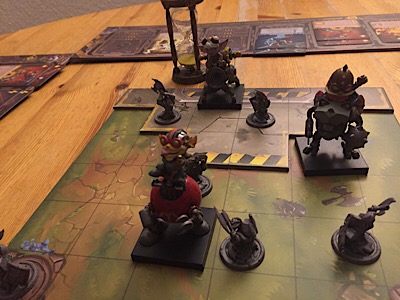 I guess you already have concluded that I like Mech vs. Minions. In a certain sense, I really fell in love with the game. I mean, all the excellent and well packed game material, the funny story-driven campaign and the simplicity, but ingenuity of the rules: all of this definitely is worth a G@mebox Star. That lead us to the final question: Is Mech vs. Minions better than Robo Rally? Well, that depends: First of all both games demand visual thinking from the players. So if you don't like this, you probably won't get along with any of the two games. If you prefer cooperative games with a lot of (necessary) coordination among the players and puzzle elements, I would think Mech vs. Minions could be the better choice. Robo Rally on the other hand is the more chaotic and competitive variant. And it forgives you wrong programming, because each turn you start with an empty command line again. If, however, you ask me: I think both games are a must-have. | ||
|
| ||

|
|

|
|
| ||
|
Impressum / Contact Info / Disclaimer Kulkmann@aol.com
Copyright © 2017 Frank Schulte-Kulkmann, Essen, Germany | ||